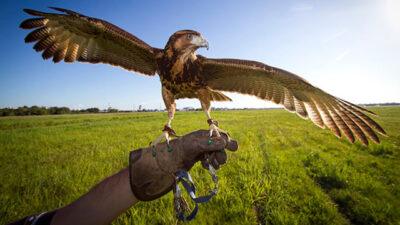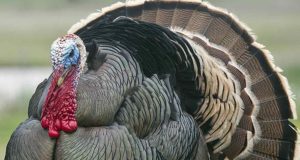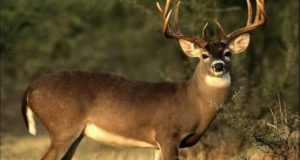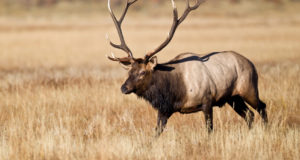|
Listen To The Article
|

Image source: global.ralphlauren.com
A peregrine falcon flies high above, the clean lines of its wings cutting through the sky. It circles once and then swoops down low, coming in ever closer, until it lands gracefully on your gloved hand. You feed it a tidbit of raw meat and gently toss it back into the air. Once it has gained altitude, it beings to dive and you look to where a duck is flying slow and heavy. The Peregrine strikes hard and the two come to rest on the muddy banks of the pond. After allowing the bird a taste of her catch, you coax her onto your fist and pocket the duck.
Falconry isn’t for everyone. It requires significant training before you are ready to legally own and hunt with a raptor. You will need to devote considerable care and time to training and maintaining your bird. You will need to invest in quality equipment and housing for your bird. But, just like hunting with dogs, birds of prey offer a unique and rewarding hunting experience. Ducks, doves, rabbits, squirrels and other small prey are all possibilities.
There are a number of different raptors, including hawks, accipiters, eagles, falcons, and owls, but you will most likely be starting with a red-tailed hawk or an American kestrel. Both are excellent beginner birds, though a kestrel needs more care and attention than a red-tail, as they are easier to accidentally kill due to their small size. When you trap your first red-tail, you’ll want to look for a strongly banded tail (horizontal black bands running across the tail feathers). This signifies that the hawk is a first-year bird. The banding becomes less distinct after the first-year molt.
Red-tailed hawks are fairly adaptable when it comes to hunting; they hunt small rodents, voles, snakes, mice and even rabbits in the wild. They prefer to hunt from a perch as they are slower flying birds and use gravity to build momentum. You will see them in the wild perched high on a tree or telephone pole along the highway, or on the edge of woods overlooking a field. Raptors are serious creatures and not affectionate. They form a working relationship with their handler but they never become “pets.” Raptors are-awe inspiring birds in flight and they can be a joy to hunt with.
You can expect to spend anywhere from $700 to $2,500 or more to get started. This includes costs of the various pieces of equipment and facilities you will need as well as the licensing fees. You can make some of your equipment, like jesses, leashes and lures, but you will still need to invest in quality leather and hardware. What this estimate doesn’t include is the cost of feeding your bird. The costs of this can vary greatly depending on where you live and what is available to you. Some falconers raise their own chicks and mice to help offset the cost and ensure their bird has fresh meat. Notice also that this estimate does not include the cost of a bird. You will be trapping your bird from the wild.
Story continues below video
The first thing you will need to do is find a falconry club or group. You can also request a packet of information from the Department of Fish and Wildlife in your state. The department may have a website with the necessary information on it as well. While it is legal to practice falconry in 49 states (Hawaii does not allow falconry for fear of escaped birds impacting the ecosystem), there are a number of regulations. When you start out, you will need to find a sponsor, pass a written state falconry test, and have your mews (housing) inspected in order to receive your apprentice falconer permit. The sponsor will take you under their wing (no pun intended) for two years and teach you everything you need to know to start out. Licensed falconers are not required to sponsor you, so be polite and realize that their lives are busy already with juggling family, job and the needs of their bird(s). Be genuine and patient. Many sponsors require an interested person to accompany them for a year before agreeing to sponsor them as it is a big commitment and they need time to evaluate your interest level. You will find dedicated, passionate people among the falconry crowd, and they will be able to guide you as you begin the process of becoming a licensed falconer.
Story continues below video
Most likely, once you find a sponsor, you will be accompanying them on hunts. When on a hunt, be respectful of the handler and raptor. Birds of prey tend to be a shy group and can be unnerved by strangers. Avoid making loud noises and take your cues from the handler. Watch how your sponsor handles the bird, and how he uses the equipment. If he is hunting with dogs, watch how he interacts with them and how he moves in once the bird has downed its prey. You can learn a lot by attentiveness, but don’t be afraid to ask questions after the hunt as well.
As you try to determine if falconry is for you, read a lot. There a number of good books out there on apprenticing, the basics of falconry, training and raptor biomedicine. The Modern Apprentice website is a great place to start. Pennsylvania Falconry and Hawk Trust lists some excellent resources as well. Accompany licensed falconers on hunts a few times and attend falconry meets. Evaluate your lifestyle to make sure there is room for the demands and expense of a raptor. Falconry takes dedication, time and patience, but for many, it is a rewarding experience.
Sign up for Off The Grid News’ weekly email and stay informed about the issues important to you
 Off The Grid News Better Ideas For Off The Grid Living
Off The Grid News Better Ideas For Off The Grid Living




